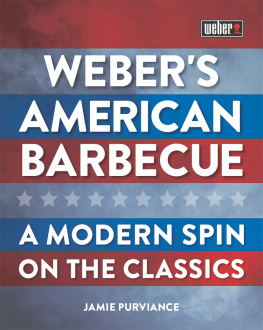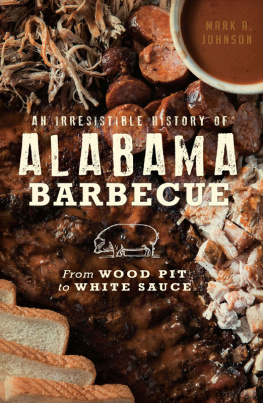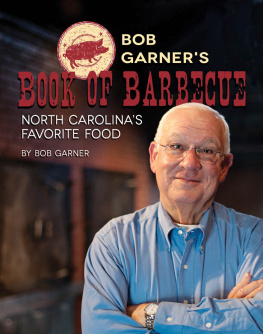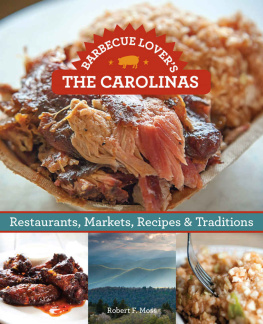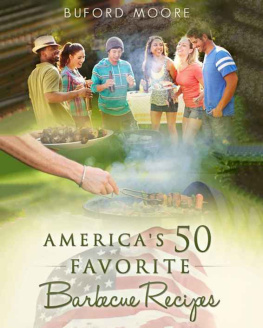
Cover design by Alessandro Migliorato Milan, Italy
Cover photos:
Front bottom left brisket and sausage from Salvage BBQ
Front left middle pork from Wilbers Barbecue
Front top left ribs from Bravo Farms Smokehouse
Front top middle ribs from Hometown Bar-B-Que
Front top left tray from Freedmens Bar
Front middle Johnny at Bates City Bar-B-Que
Back top Opies BBQ
Back 2nd Maurices Piggie Park
Back 3rd Gates Bar-B-Q
Back 4th Skylight Inn BBQ
Back 5th Central BBQ
Back bottom Mike Emerson (Pappys Smokehouse) and Johnny
Copyright: 2015 Renew Press
ISBN: 978-0-9962333-0-9
All photos by Johnny Fugitt except for Chicago q - Lindsey Cavanaugh, Eat Pray Photo; The Shaved Duck - courtesy of The Shaved Duck
Some names and identifying characteristics have been changed.
Every effort has been made to make this book as helpful and accurate as possible. As the restaurant world changes every day, the information for restaurants may have changed since publication.
The 100 Best Barbecue Restaurants in America
Caution: Side effects of this book may include late night cravings, spontaneous road trips and the meat sweats. Not all material may be appropriate for vegetarians. Carnivore discretion is advised.
Introduction
Barbecue is American art. Its the smell and taste of our great country. Despite unresolved debates over our national cuisine, we find beauty in the diversity of our backgrounds, tastes and traditions. Barbecue is the quintessential American meal for a gathering of friends, families and communities. Barbecue reaches all demographics and walks of life. Its meant to be shared. The smell of barbecue transports us to another place and time, yet defines comfort food for the here and now. Its historic and traditional, yet current and evolving. The smell of smoke is common throughout the world, but we created our own unique methods, tastes and styles to produce something distinctly our own. Distinctly American.
Barbecue means summertime and baseball. It means road trips and returning to ones roots. It means urban hole-in-the-walls and small town joints where everyone is known by name. It means third-generation families working long hours to uphold the family name as well as entrepreneurs chasing a dream. It means more to restaurant owners than making a living. It means providing for their children, creating jobs for their neighbors, giving to their communities and creating something that makes people happy. Early in Julia Childs career, she was spurned by editor after editor who said Americans were unwilling to give the time and effort necessary to follow Julias French recipes. These editors were, as you know, wrong. The pace of life has only increased since Julias time, but the popularity of barbecue, a food that requires even more time and effort than French cooking, has increased as well. This paradox actually makes sense. The busier we become, the more we appreciate that which takes significant time and effort to create.
Food is about more than sustenance. Good food slows us and reminds us to enjoy life. No food requires as much time and effort as barbecue and no food provides the same sense of place, people and purpose. Its part of who we are as individuals. Its part of who we are as a people.
In one year, I did two things that speak to the American spirit. First, I hit the open road. My barbecue travels took me to the 48 contiguous states. I met owners, pitmasters, chefs, managers, servers and bartenders who make American culture, as well as Americas barbecue. Second, I did something unprecedented. No one had attempted a project like this. I visited more barbecue restaurants across a greater geographic area in a condensed amount of time than anyone. Ever!
This book is the summation of that experience. It started with the question What are the best barbecue restaurants in America? and ended with a story as well as an answer.
The Beginning
Our culture is obsessed with lists and rankings. Buzzfeed successfully digitized the crack cocaine that is cultural rankings and now every smartphone in America deals this addictive substance 24 hours a day. At a superficial level, there is something in us that wants to visit or experience the best. At a deeper level, though, experiencing anything at its highest level, from architecture to a pork sandwich, is experiencing beauty and art.
When a local writer or reporter publishes a ranking of the best burgers, drinks or things to do in town, Im all over it. In the last five years, nearly every city has received a list like Top 5 Barbecue Restaurants in New York, Best of Birminghams Barbecue or The Top Ten BBQ Joints in Austin. For most of these lists, a writer will visit 10, 20 or 30 local barbecue restaurants to pick their favorites. Their opinions are, of course, subjective, but they back up their rankings by explaining their preferences, tastes and reasoning.
When you look at the 10 Best Barbecue Restaurants in America lists, and there is a new one every week on click-sucking sites like Eater, Thrillist, Huffington Post, etc., you find lists that should instead be titled The 10 Most Historic Barbecue Restaurants in America or The 10 Best Marketed Restaurants in America. Some of these lists do not provide authors. When one list cited an author, the writer was forced to eat smoked crow when he admitted to not visiting all of the restaurants on the list - let alone visiting others to determine that those on the list were really the best. Some lists are nothing but marketing in the same vein as the Best Steakhouses in America ads you see in airline magazines. Other lists are conglomerations from multiple writers. A national publication might ask a handful of writers from places like Kansas City, Texas, Memphis, the Carolinas, D.C., New York, Chicago and California for nominations and push them all together.
These methods, obviously, have their flaws. I wanted to see the local model used at a national scale and was surprised no one had done it. Barbecue books are big business these days, but they primarily focus on history, recipes or technique. Since I could not find an extensive, well-researched guide to barbecue restaurants, I saddled up the Subaru and hit the road. As you will soon see, it was the adventure of a lifetime.
As soon as I shared my project to anyone while traveling, I was peppered with a number of questions. How did you decide which restaurants to visit? Did you eat the same thing at each restaurant? What kind of barbecue do you prefer? First, I want to share my methodology and answer some of these burning questions you may have. Second, in just one chapter, Im going to share much of what I learned about barbecue over the course of the year. Ill share a few stories from the road and proceed to my list of The 100 Best Barbecue Restaurants in America. At the end, I have an awards section (Top 10 Ribs, Top 5 Baked Beans, etc.) and a quick reference guide.
Crisscrossing America:
Project FAQs
Why barbecue?
Everyone thinks themselves an expert on three things: God, Politics and Barbecue. These three topics elicit firmly entrenched views, debate and disagreement. I have always been a casual barbecue enthusiast and wanted to fan the flames of the great barbecue debate. I spent some of my childhood in Kansas City and North Carolina and remember visiting Kansas City favorites like LCs as a teenager. My amateur attempts with the backyard smoker only increased my appreciation of barbecue restaurants.
Who are you to make this list?
Im not a competition barbecue participant or judge. Im not a restaurateur. Im not a trained chef. I am, however, the person who has visited more barbecue restaurants across a greater geographic area in a condensed amount of time than anyone. Daniel Vaughn,
Next page

